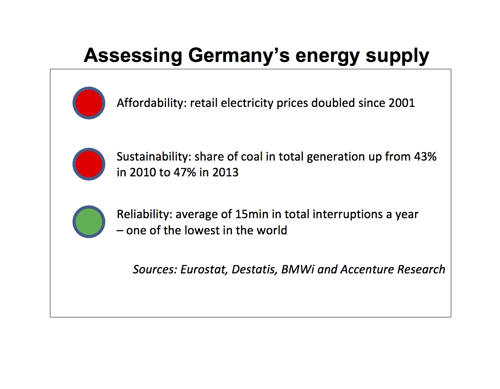Lessons for U.S. Utilities from the German Energiewende
Energiewende has become one of the most talked about topics in the utilities industry and perhaps one of the most notorious. It has also become the example of how not to do energy policy. And while this may be true in many respects, the strategy has been successful in certain areas, least of which is providing learnings for other countries.
[Editor's note: Find background and more
information on the Energiewende plan---
Energiewende is German for "energy
transition"---by
clicking here.]

Germany was the first mover with an ambitious
national energy transition agenda, and as with
most things untested, there is always an
expectation of some challenges and unintended
consequences.
Today, most experts would argue that the
Energiewende tried to do too much, too fast. The
drive for renewables growth, supported with
generous subsidies, has led to an explosive
growth in solar power, which now makes up more
than 20 percent of installed capacity. This was
combined with an aggressive mandate for nuclear
decommissioning in the wake of the Fukushima
disaster.

In addition to creating a number of unintended
consequences, this agenda failed to achieve many
of its original objectives.
Firstly, German consumers are paying twice as
much for electricity as their U.S. counterparts
and prices for industrial customers have risen
by more than 30 percent over the last four
years.

Secondly, German utilities have lost more than
half their market capitalization in recent
years, while U.S. utilities are still achieving
fairly healthy returns on equity.
Thirdly, the Energiewende has inadvertently
driven up Germany's carbon emissions, since the
country has been relying on its own lignite coal
resources and cheap imports from the U.S. as
back up load, when the nuclear moratorium was
introduced.

Many countries, including the U.S., have been
watching Germany's experience closely as they
manage through a transition to a greener energy
system. The U.S., however, does exhibit a major
structural difference to Germany - the
unexpected shale gas boom, which has been the
single largest contributor to CO2 emission
reductions. That said, all countries that have
enacted policies to encourage the growth in
renewables have one thing in common -
projections have significantly exceeded original
forecasts as technology costs have plummeted at
a much faster rate than expected.
For this reason utilities and policy makers
should take into account key lessons from the
Energiewende, both at a system-wide and at a
company level.
At a system-wide level, this means more
integrated policy planning that takes into
account long-term impacts across the entire
energy value chain. This includes the impact on
the generation mix, on wholesale and retail
prices (and their impact on the economy), and on
the operations and reliability of the grid.
Integrated planning must also consider the
effects of tariffs such as net metering on the
economic viability of the grid, interdependency
of future technologies such as storage and the
likelihood of potential reduced usage of the
grid if consumers start to utilize it simply as
a source of peak or backup power.
This system-wide scenario planning must be a
result of collaboration between policymakers,
regulators, utilities and consumers in order to
arrive at a balanced solution.
At a company level, it is clear that the rapid
growth in distributed generation will require a
different operating model that not only allows
utilities to manage a more complex and
distributed grid but also positions utilities to
be an active participant in the transformation
of the grid.
From an operational perspective, the growth in
distributed generation places significant stress
on the networks. Utilities will need to upgrade
their use of analytics and advanced distribution
management systems in order to operate a much
more complex asset base. For example, in
Germany, as much as 70 percent of solar power is
connected to the low voltage grid. So, not only
are utilities not generating any revenue from
solar, they need to fund substantial upgrades to
a distribution grid that was not designed for a
distributed and intermittent power model.
From a financial and commercial perspective,
utilities need to develop a long-term plan to
manage the effects of reduced centralized demand
and, if possible, become a participant in the
provision of new services to its customers, such
as distributed generation, storage and
microgrids, to complement traditional grid based
offerings.
In Germany, utilities have been slow to invest
in renewables and own only about seven percent
of total installed capacity. And while solar
penetration in most U.S. states is still
relatively low, our analysis shows that the
entire country is likely to be at grid parity by
2030, especially as solar prices continue to
drop.
Additionally, our latest research shows that
U.S. consumer interest in residential solar
installations is expected to increase from six
percent to 43 percent in the next five years.
And while specialized providers are still the
default choice for consumers, utilities are a
very close second. Despite their entrance into
the energy market, retailers, phone and cable
companies and online service providers rank much
lower.
Utilities are well positioned to capture these
new revenue streams, and even though they
currently lack the necessary regulatory support,
scale and core competencies to effectively
respond to this opportunity, especially in
non-competitive states, many are finding ways to
enter new and adjacent markets through
partnerships, acquisitions and unregulated
entities.
The pain felt in Germany can certainly be
avoided here, but utilities need to realize the
opportunity and get ahead of these developments
by engaging with policymakers to reshape the
regulatory framework. Utilities also need to
develop a long-term commercial assessment of how
they will operate in a world where consumers
have much more diverse requirements and options
to address their energy needs.
![]()
To subscribe or visit go to: http://www.riskcenter.com
http://riskcenter.com/articles/story/view_story?story=99917080